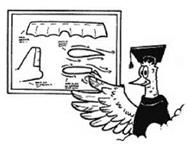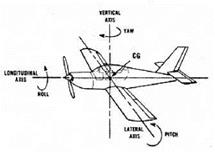How Airplanes Fly, Part 2: The Aerodynamics of Flight
|
|
In This Chapter
► Pitch, roll, and yaw
Lift: the key to flying an airplane V Drag: an unavoidable cost of flying >• Thrust: the driving force in airplanes >■ The turn: one maneuver, many forces
In the last chapter we discussed the components that make up the airplane. In this chapter, we’ll learn how those components work together to enable an airplane to fly.
Pivot Points: Pitch, Roll, and Yaw
When the pilot controls the ailerons, Haps, elevators, and rudder surfaces, he brings the three axes of motion into play.
Imagine a small toy airplane. If you imagine a wooden dowel or a metal wire running the length of the airplane from the tip of the propeller to the tip of the tail (the point where the vertical and horizontal stabilizers meet), you’re visualizing the “longitudinal axis.” Rotation around the longitudinal axis is accomplished by using the ailerons, and is called “roll.” The pilot controls roll by turning the control column, or “steering wheel,” left and right.
Now imagine a wire running from one wingtip to the other. This is roughly the position of the “lateral axis.” The airplane pivots around this axis as a result of moving the elevators, and such pivoting is called “pitch.” The pilot controls pitch by pushing the control column in and out.
Finally, imagine the place where the longitudinal and lateral axes meet. If you were to run a wire vertically through that point, that would represent the “vertical axis,” which the pilot controls using the rudder. Movement around the vertical axis is called “yaw.” The pilot controls yaw by using the foot pedals.
|
When an airplane is in flight, its movements take place around its longitudinal, lateral, and vertical axes. (FAA Flight Training Handbook) |
To sum up:
•The aileron control surfaces located on the wings, and moved by turning the control column left and right, cause roll around the longitudinal axis.
•The elevator control surfaces located on the horizontal stabilizers, and moved by pushing the control column in and out, cause pitch around the lateral axis.
•The rudder control surfaces located on the vertical stabilizers, and moved using the foot pedals, cause yaw around the vertical axis.
The three airplane axes meet at a single point called the “center of gravity,” which is also the point where airplane designers consider the aerodynamic forces of flight to be concentrated. The center of gravity is a significant factor in such areas as calculating the stability and the maneuverability of an airplane, though that is a factor we generally leave to the engineers.














